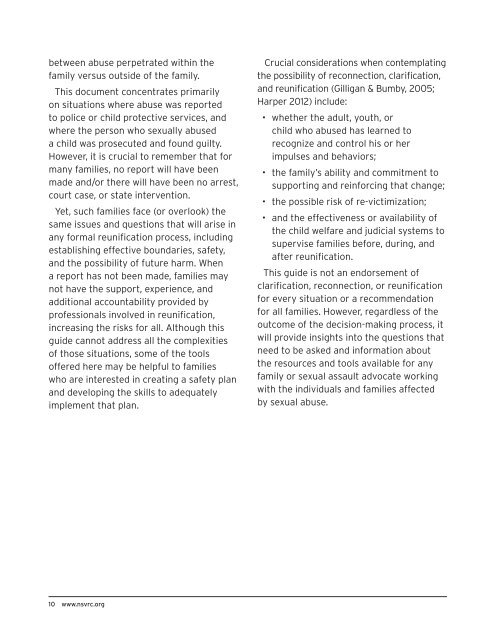Considering Family Reconnection and Reunification after Child Sexual Abuse
1VwGeds
1VwGeds
You also want an ePaper? Increase the reach of your titles
YUMPU automatically turns print PDFs into web optimized ePapers that Google loves.
etween abuse perpetrated within the<br />
family versus outside of the family.<br />
This document concentrates primarily<br />
on situations where abuse was reported<br />
to police or child protective services, <strong>and</strong><br />
where the person who sexually abused<br />
a child was prosecuted <strong>and</strong> found guilty.<br />
However, it is crucial to remember that for<br />
many families, no report will have been<br />
made <strong>and</strong>/or there will have been no arrest,<br />
court case, or state intervention.<br />
Yet, such families face (or overlook) the<br />
same issues <strong>and</strong> questions that will arise in<br />
any formal reunification process, including<br />
establishing effective boundaries, safety,<br />
<strong>and</strong> the possibility of future harm. When<br />
a report has not been made, families may<br />
not have the support, experience, <strong>and</strong><br />
additional accountability provided by<br />
professionals involved in reunification,<br />
increasing the risks for all. Although this<br />
guide cannot address all the complexities<br />
of those situations, some of the tools<br />
offered here may be helpful to families<br />
who are interested in creating a safety plan<br />
<strong>and</strong> developing the skills to adequately<br />
implement that plan.<br />
Crucial considerations when contemplating<br />
the possibility of reconnection, clarification,<br />
<strong>and</strong> reunification (Gilligan & Bumby, 2005;<br />
Harper 2012) include:<br />
• whether the adult, youth, or<br />
child who abused has learned to<br />
recognize <strong>and</strong> control his or her<br />
impulses <strong>and</strong> behaviors;<br />
• the family’s ability <strong>and</strong> commitment to<br />
supporting <strong>and</strong> reinforcing that change;<br />
• the possible risk of re-victimization;<br />
• <strong>and</strong> the effectiveness or availability of<br />
the child welfare <strong>and</strong> judicial systems to<br />
supervise families before, during, <strong>and</strong><br />
<strong>after</strong> reunification.<br />
This guide is not an endorsement of<br />
clarification, reconnection, or reunification<br />
for every situation or a recommendation<br />
for all families. However, regardless of the<br />
outcome of the decision-making process, it<br />
will provide insights into the questions that<br />
need to be asked <strong>and</strong> information about<br />
the resources <strong>and</strong> tools available for any<br />
family or sexual assault advocate working<br />
with the individuals <strong>and</strong> families affected<br />
by sexual abuse.<br />
10 www.nsvrc.org


